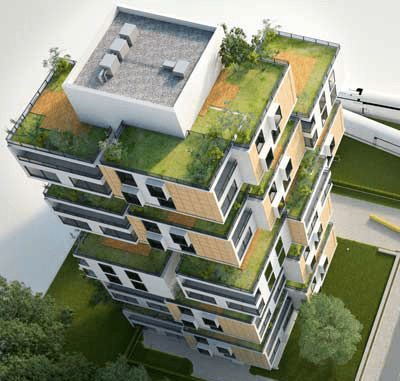Neha Das
Indian Institute of Technology, Roorkee, India
(Corresponding Author: nehadas19nd@gmail.com
E. Rajasekar
Indian Institute of Technology, Roorkee, India
Prabhjot Chani
Indian Institute of Technology, Roorkee, India
Krishan Sharma
Alliance for Energy Efficient Economy, New Delhi, India
Cite this article
Highlights
- Thermal mass on the interior side and insulation on the exterior side of walls exhibit better thermal performance in cold climates.
- It reduces the HED by 4% and HDD by 3% across the different climate severities.
- The South orientation is preferred over other orientations.
- Higher WWR leads to higher energy consumption and heat loss.
Abstract
This study investigates the effect of thermal mass and insulation position on the thermal performance of residential buildings in a cold climate. A combination of numerical simulations and field measurements is employed to assess the impact of different wall configurations on heating energy demands and comfort. Configurations with thermal mass placed on the interior side of walls exhibit better thermal performance, reducing temperature fluctuations and enhancing thermal comfort. The study also explores the influence of climate severities, changing the window-to-wall ratio and building orientation on energy savings and comfort for various wall configurations. Wall B (thermal mass inside and insulation outside) reduces HED by 4% and HDD by 3% across different locations. Wall B reduced HED by 9.8% and HDD by 1.4% for a south facing building, and reduced HED by 3.2% and HDD by 2.2% for 10% WWR.
Keywords
Thermal Performance, Thermal Mass, Insulation, Residential Buildings, Cold Climate.
References
- India energy outlook report (IEA), “India Energy Outlook,” World Energy Outlook Spec. Rep., pp. 1-191, 2021, [Online]. Available: http://www.worldenergyoutlook.org/media/weowebsite/2015/IndiaEnergyOutlook_WEO2015.pdf
- J. Yu, C. Yang, L. Tian, and D. Liao, “A study on optimum insulation thicknesses of external walls in hot summer and cold winter zone of China,” Appl. Energy, vol. 86, no. 11, pp. 2520-2529, 2009. https://doi.org/10.1016/j.apenergy.2009.03.010
- E. Kossecka and J. Kosny, “Influence of insulation configuration on heating and cooling loads in a continuously used building,” Energy Build., vol. 34, no. 4, pp. 321-331, 2002. https://doi.org/10.1016/S0378-7788(01)00121-9
- S. A. al-Sanea and M. F. Zedan, “Effect of insulation location on initial transient thermal response of building walls,” J. Build. Phys., vol. 24, no. 4, pp. 275-300, 2001. https://doi.org/10.1106/07E7-FGCJ-MFF7-974W
- K. Leonidaki, E. Kyriaki, C. Konstantinidou, E. Giama, and A. M. Papadopoulos, “Thermal performance of office building envelopes : the role of window-to-wall ratio and thermal mass in Mediterranean and Oceanic climates,” vol. 94, no. 2, pp. 1-7, 2014.
- A. Reilly and O. Kinnane, “The impact of thermal mass on building energy consumption,” Appl. Energy, vol. 198, pp. 108-121, 2017. https://doi.org/10.1016/j.apenergy.2017.04.024
- N. Das et al., “Comparative evaluation of thermal performance and energy conservation of residential buildings in cold climate of India,” in PLEA STGO 2022: Will cities survive ?, 2022, pp. 813-817.
- S. Manu, Y. Shukla, R. Rawal, L. E. Thomas, and R. de Dear, “Field studies of thermal comfort across multiple climate zones for the subcontinent: India Model for Adaptive Comfort (IMAC),” Build. Environ., vol. 98, pp. 55-70, 2016. https://doi.org/10.1016/j.buildenv.2015.12.019
- ANSI/ASHRAE, “ANSI/ASHRAE Standard 55-2017 : Thermal environmental conditions for human occupancy,” ASHRAE Inc., vol. 2017, p. 66, 2017, ISSN 1041-2336.
- S. K. Negi, H. K. Jain, and V. Singh, “Architecture of Uttarakhand and construction techniques for affordable housing,” J. Environ. Nanotechnol., vol. 6, no. 2, pp. 30-35, 2017. https://doi.org/10.13074/jent.2017.06.172247
- BSI, “BS EN ISO 13786 : 2017 BSI Standards Publication Thermal performance of building components – Dynamic thermal characteristics – Calculation methods,” no. August, 2018.
- SP 41, “(S&T) Handbook on functional Requirement of Buildings other than industrial buildings,” Bur. indian Stand. India, pp. 33-40, 1987.
- S. A. Al-Sanea and M. F. Zedan, “Improving thermal performance of building walls by optimizing insulation layer distribution and thickness for same thermal mass,” Appl. Energy, vol. 88, no. 9, pp. 3113-3124, 2011. https://doi.org/10.1016/j.apenergy.2011.02.036
- F. Nicol and M. Humphreys, “Derivation of the adaptive equations for thermal comfort in free-running buildings in European standard EN15251,” Build. Environ., vol. 45, no. 1, pp. 11-17, 2010. https://doi.org/10.1016/j.buildenv.2008.12.013
- C. Chang, N. Zhu, K. Yang, and F. Yang, “Data and analytics for heating energy consumption of residential buildings: The case of a severe cold climate region of China,” Energy Build., vol. 172, pp. 104-115, 2018. https://doi.org/10.1016/j.enbuild.2018.04.037
- B. Pandey, N. Das, S. Suman, and R. Elangovan, “Guidelines for climate-responsive and low carbon building design in the cold lcimate of Uttarakhand,” New Delhi, 2023.

 Bishal Thapa
Bishal Thapa





 Fred Sherman
Fred Sherman Sumedha Malaviya
Sumedha Malaviya Satish Kumar
Satish Kumar












 The three main global energy concerns of providing access to modern energy, enhancing the security of the energy supply, and minimising the impact of energy systems on the climate have an impact on both national and international energy governance. To develop solutions that address the many facets of these difficulties, however, a variety of actors and stakeholders must be included due to the complexity of the energy challenges.
The three main global energy concerns of providing access to modern energy, enhancing the security of the energy supply, and minimising the impact of energy systems on the climate have an impact on both national and international energy governance. To develop solutions that address the many facets of these difficulties, however, a variety of actors and stakeholders must be included due to the complexity of the energy challenges. Cities are responsible for more than 70% of the world’s energy consumption and 40% to 50% of its greenhouse gas emissions. Managing increasing urbanisation is a challenge, and nations must deal with the effects it will have on the environment in terms of energy and climate.
Cities are responsible for more than 70% of the world’s energy consumption and 40% to 50% of its greenhouse gas emissions. Managing increasing urbanisation is a challenge, and nations must deal with the effects it will have on the environment in terms of energy and climate. Our transition to a future with lower carbon emissions depends heavily on buildings. They are our places of residence, rest, and employment; they also account for around one-third of the world’s greenhouse gas emissions and nearly 40% of the world’s energy usage.
Our transition to a future with lower carbon emissions depends heavily on buildings. They are our places of residence, rest, and employment; they also account for around one-third of the world’s greenhouse gas emissions and nearly 40% of the world’s energy usage.